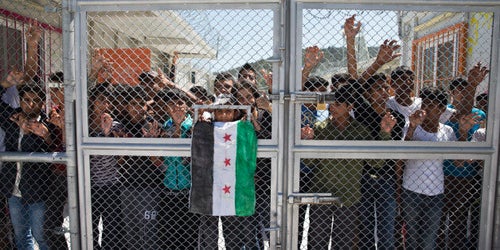

In the clinic where I provide medical care in Greece there is a child's drawing on the wall. Crayon colours on tattered paper show a family in front of their home; the house is still standing, and the family is still intact. The drawings next to it are of guns and explosions. Outside the clinic, bleaching beneath the Greek sun, there are rows of tents; accommodation for almost two thousand people. Refugees from Syria, Iraq, and Afghanistan have lived under these canvases for months already. They have been stranded after Europe closed its borders and the EU devised a controversial and morally compromising plan to return refugees to Turkey. There are more than fifty camps like this in Greece, for tens of thousands of refugees. In this camp, like most others, roughly a third of the inhabitants are children, and many are unaccompanied by family.
People here have traveled far beyond breaking point in journeys they never wanted to undertake. They have fled conflict and survived dangerous and desperate voyages. Many have bullet wounds; all have lost homes, families, friends, and certainties. They have been broken and are trying to rebuild: in prayers at the camp's makeshift prayer room; in classes at the small school staffed by volunteers; at the couple of market stalls that have sprung up selling cigarettes, shampoo, and vegetables; and at the chair set in front of a broken mirror and shaded by a scrap of tarpaulin where a resourceful Syrian barber gives his customers back some dignity. Many people carry smartphones with photographs attesting to interrupted lives and happier times; like the crayoned house, these images represent a precious past and a longed-for future.
Today Mahmood is rushed into the clinic, carried by a brother, followed by his mother. Unconscious, unresponsive, but still breathing. The nurse swiftly attaches an oxygen saturation monitor, straps on a blood pressure cuff, and urgently pinpricks a blood glucose, while I try to establish what happened. 'He just collapsed,' our translator says, condensing the story.
Mahmood is from Syria. I have a feeling that he should look older than his fourteen years, but he doesn't, he just looks like any other young teenager in Europe. 'Mahmood, can you hear me?' My best efforts in Arabic elicit no response. But the numbers come out fine: his heart rate is just a little high, his breathing just a little shallow. Behind me his mother sighs. It has happened again. These episodes have occurred intermittently since the family left Damascus. A young boy's psychosomatic response to trauma. We stay with Mahmood until he feels calm and able to leave.
As a doctor, it is often easier to isolate my medical work from what lies outside the clinic; to see the patient, but not their social context and its political antecedents. It is learned behaviour: there were no lectures in politics at my medical school and my clinical training in patients' 'social history' focussed on the number of cigarettes smoked and alcohol units consumed. But the socio-political context is too blatant to be ignored at the refugee camp in Northern Greece, where I work with the medical humanitarian organisation Doctors of the World. Health problems here are too often the consequence of conflict, forced migration, and delayed access to medical care. There are too many people with dangerously uncontrolled diabetes, disabling untreated injuries, or unmonitored pregnancies. And there are too many panic attacks, acts of self-harm, episodes of unexplained collapse and unconsciousness, and too many children who have started bedwetting again. The crayoned home on the clinic wall is a powerful symbol. It is an assertion of the importance of social wellbeing to health; it is a call for urgent political action in the resettlement of refugees, especially unaccompanied children; and it is a poignant daily reminder for me of how the continuing refugee crisis at the edge of Europe is being permitted by a moral crisis at its heart.